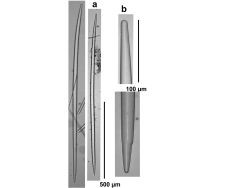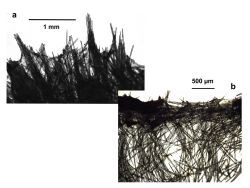yellow
cinnamon-tan
orange-yellow
lobate
tube
tough
Colombia
Axinyssa yumae
Description: (Excerpt from Zea et al., 2013) Groups of volcano-shaped mounds to tubes or cylindrical branches, 2–15 cm high, 2–5 cm wide, arising from a basal mass, up to 10–15 cm wide. Surface rugose, sometimes honeycombed, loosely to heavily fouled. Oscules on top of mounds, up to 1 cm in diameter, with a slightly elevated collar. Consistency toughly compressible, spiculose, difficult to tear. Color orange-yellow, with brownish, reddish and vinaceous tinges; interior cream; fixed specimens cream. Ectosome organic; pinacoderm supported and pierced by choanosomal spicule tracts. Choanosome non-cavernous; skeleton dense, made of closely packed ascending tracts, 2–10 spicule across, up to 180 µm wide, more confused below the surface. Spicules slightly curved anysostrongyloxeas (fusiform styles), with the rounded end narrower than the middle, and the pointed end stair-stepped to mucronated; length 606–1316 µm (specimen means 727–1121 µm); width 5.2–37.4 µm (specimen means 12.2–18.8 µm).
Notes: (Excerpt from Zea et al., 2013) This is a rare species in shallow hard bottoms. At Santa Marta it occurs deep in reefs, 15–25 m in depth, growing on dead sides or on top of dead corals, and on sand and rubble. The species was originally described under the genus Dictyonella, and later erroneously synonymized with Axinyssa ambrosia (de Laubenfels, 1936) (also pictured in this guide). However, it is a valid, different species. For comparisons see A. ambrosia notes.
Author Reference: (Pulitzer-Finali, 1986)
Link: World Porifera Database

![<i>Axinyssa yumae</i> <br />[Colombia, Santa Marta]](mini/00066/01817.jpg)
![<i>Axinyssa yumae</i> <br />[Colombia, Santa Marta]](mini/00066/01820.jpg)

